BOOK YOUR TOUR

Facts ll
Entry Regulations ll Time
Difference ll Currency
ll Climate ll Clothes
ll People
Social Behaviour ll Languages
ll Religion ll Festivals
ll Cuisine ll Alcoholic
Drinks
Electricity ll Telecommunication
ll Women Travel ll
|
|
Entry Regulations
Foreign nationals wishing to visit India must be in possession of a valid passport and a visa granted by an Indian mission abroad. Indian missions are located in 140 countries of the world.
The government of India does not allow any visa-free entry. Nationals of Nepal and Bhutan are exempted from obtaining a visa. They can enter India without a passport and visa provided they have their identity papers.
Visas are of different kinds. The period of their validity is subject to certain restrictions. The visa must be checked before entering India. All visas specify the number of times a visitor may enter a country. a multi-entry visa must be obtained if one is visiting some of the neighboring countries like Nepal and Sri Lanka and re-entering India.
Indian Embassies Abroad
Time Difference
Indian standard time is 5 ½ hours ahead of Greenwich means time and 10 ½ hours ahead of us east. Thus noon in India is 1:30 a.m. in New York. Nepal stick to its ancient sundial time which is ten minutes ahead of Indian standard time. Indian standard time has no variation in summer or winter.
TopCurrency
Indian
currency is based on the decimal system-100 paise to the rupee.
Coins are in the denominations of 5, 10, 20, 25, and 50 paise,
though 5, 10 and 20 paise coins have virtually vanished, thanks to
inflation. Bank notes are in the denominations of 1,2,5,10,20,50,100,500,1000
rupees.
Foreign currency regulations :
You may bring in any amount of foreign currency or
traveller's
cheques to India. It is desirable to declare it in the currency
declaration form handed out to you at the time of arrival. If you
have only $ 1,000 you need not declare it.
When you change your money in Indian currency, do it at the branch
of a bank or go to an authorized moneychanger. Get an encashment
receipt from the moneychanger. It helps you to reconvert the
leftover Indian currency. In metropolitan or other major cities, it is possible to change
currency at airports, hotels and banks. In small towns there may
be a little problem. So change your money before you go to a small
town. It may be advisable to bring some US dollars or British
pounds, which can exchange more easily in smaller tourist centers.
Climate
Climate
in India varies greatly according to latitude, altitude and season.
Temperatures: Average maximum winter temperatures range from the
high 20 degree celsius in the S to below freezing in parts of
Kashmir, Leh and Ladakh, and the low 20 degree celsius on the
northern plains. The range of minimum winter temperatures between
N and S is greater. In many parts of the N plains, especially
in the NW, close to the foothills of the Himalayas, night temperatures
fall close to freezing. In contrast, in the far S, minimum temperature
never fall below 20 degree celsius except in the hills.
In summer the N is generally hotter than the S, with daytime temperatures
usually over 40 degree Celsius and in parts of the NW up to nearly
50 degree Celsius from time to time. Night time temperatures also
remain high. The end of Apr - May is the hottest time. Once the
clouds of the monsoon season arrive temperatures fall a few degrees,
but the air gets much more humid, often making it intensely uncomfortable.
In the S max temperatures never reach those experienced in the
N, rarely rising above 40 degree celsius for more than a day or
at a time. May is also generally the hottest month.
Rainfall
: India's seasonal rainfall pattern is dominated by the monsoon,
which generally arrives at the SW coast in late May or June, covering
most of the country by the beginning of July, and retreating in
October. However, the popular image of the monsoon is misplaced.
Even in the wettest areas - the west coast or the NE hills of
the shillong plateau - there are periods of days at a time when
it does not rain. Elsewhere the rainy season is marked by prolonged
very heavy showers, interspersed with cloudy, humid weather and
occasional bright patches.
Clothes |
 |
The people of India have colorful & different attires. The silk saris, brightly mirrored cholis, colourful lehangas and the traditional salwar- kameez have fascinated many travellers, over time. Light cotton clothes are useful almost anywhere in India at any time of year. It is a good idea to have some very lightweight long sleeve cotton and trousers for evenings, preferable light in colour, as they also give some protection against mosquitoes. Between Dec - Feb it can be cool at night even on the plains in N and E India, and at altitudes above 1,500m right across India some woolens are essential. Dress is rarely formal. In the large cities short sleeve shirt and ties are often worn for business. For traveling loose clothes are most comfortable. Indian dressing styles are marked by many variations, both religious and regional and one is likely to witness a plethora of colors, textures and styles in garments worn by the Indians |
 
|
People |
Next to China India is the country with the largest number of inhabitants in the world. Facing the fact that almost one thousand millions people are living in India it is amazing that they occupy only 2,4 % of the earth's surface. The average population density is 298 inhabitants per km2. In some areas population density reaches over 1000 inhabitants per km2 for which two reasons can be mentioned. First population remains concentrated in the big cities and around the fertile riverbeds of the Ganges and second huge parts of the country remain uninhabitable because they are covered either by desert or by high mountains. |
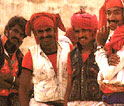 |
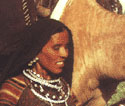 |
The
average life expectancy is 58 years, the share of young
people under the age of 18 is over 40%. Around ¾ of Indians are living in the rural area, ¼ of the population lives in cities. The biggest cities are Kolkata (formerly Kalkutta), Mumbai (formerly Bombay), Delhi and Chennai (formerly Madras). About 5 million Indians are living abroad, primarily in South and East Africa, in South-East-Asia, North America and around the Persian Gulf |
Social Behaviour |
 |
Use
you right hand for giving, taking, eating or shaking hands as
the left is considered to be unclean. Women do not shake hands
with men, as this form of contact is not traditionally acceptable
between acquaintances. Do not photograph women without permission. |
|
Languages |
||
In
India you find one of the biggest variety of languages on earth.
The number of spoken languages in India is said to be around 1650.
There is also a huge number of different dialects some of them
only spoken by a single tribe.
Even among Indians communication is not always easy while travelling
in different states due to differences of the languages. Communication
difficulties are managed by using English by a large number of
people to manage day-to-day life while travelling.
Proficiency in English in India is considered to be an extra qualification
for the jobs as well as in business.
By knowing English as a foreign guest you will definitely find
your way without having complications while travelling through
India !
About
72% of Indians speak Indo-Aryan languages, mainly Hindi (38 %),
Bengali, Bihari, Marathi, Oriya, Punjabi, Gujarati, Assami,
Kaschmiri,
Nepali and Urdu. About 25%, mainly South-Indian people, speak
Drawida languages like Tamil, Telugu, Malayalam and Kannada. The
remaining 3% speak languages of Mongolian origin.
Official languages are Hindi (Devanagari type) and English. Additionally
there are 14 regional languages (printed on every currency note)
which are officially recognised. Sanskrit, which roots date more
than 4000 years back, is the origin of most of today's spoken
languages in India. Its prevalence as the language of the ruling
and educated elite took influence on the development of other
languages all over India. Sanskrit itself is no more spoken today
although it is still recognised as one of the official languages
in India.
For
all those of you who would like to learn few words in Hindi we
have compiled the following list of vocabulary.
|
ENGLISH TERMS |
HINDI TERMS |
ENGLISH NUMBERS |
HINDI NUMBERS |
|
Greeting
|
Namaste
|
1
|
ek |
|
yes
|
Ha
|
2
|
do |
|
no
|
Nahi
|
3
|
tin |
|
Water
|
Pani
|
4
|
tschaar |
|
Food
|
Khana
|
5
|
pantsch |
|
Rice
|
Schawal
|
6
|
tsche |
|
Potato
|
Alu
|
7
|
saat |
|
Vegetable
|
Sabschi
|
8
|
aath |
|
Fish
|
Machali
|
9
|
no |
|
Spinach
|
Palak
|
10
|
das |
|
Cauliflower
|
Gobi
|
11
|
gjaara |
|
Bread
|
Roti
|
12
|
baara |
|
Butter
|
Makkhan
|
13
|
tera |
|
Salt
|
Namak
|
14
|
tschoda |
|
Coffee
|
Coffee
|
15
|
pandra |
|
Tea
|
Tschai
|
16
|
sola |
|
Milk
|
Dudh
|
17
|
satra |
|
Sugar
|
Tschini
|
18
|
ataara |
|
Cheap
|
Sasta
|
19
|
unis |
|
Expensive
|
Mehanga
|
20
|
bis |
|
Big
|
Bada
|
30
|
tis |
|
Small
|
chotha
|
40
|
tschaalis |
|
Tired
|
Thakan
|
50
|
patschas |
|
thirsty
|
Pyasa
|
60
|
saath |
|
Beautiful
|
Sundar
|
70
|
satar |
|
Today
|
Aatsch
|
80
|
assih |
|
Tommorow
|
Kal
|
90
|
nabbhe |
|
Yesterday
|
Parso
|
100
|
so |
|
Day
|
Din |
200
|
do so |
|
Hour
|
Ghanta |
1000
|
hasaar |
|
Medicin
|
Dawai | 10000 |
das hazar |
|
Room
|
Kamra |
100000 |
ek lakh |
|
Tidy
|
Saaf | ||
|
Dirty
|
Gandha | ||
|
Okay
!
|
Acha ! | ||
|
Now
|
Ab | ||
|
When?
|
Kab ? | ||
|
Do you Understand ? |
Samjhe Aap ? | ||
|
I don't speak Hindi. |
Mujhe Hindi bolni nahi aati hai. | ||
|
What is your name? |
Aap ka kya naam hai? |
Religions
It
is an almost impossible task to write down all there is to tell
about "Religions in India". No other country on earth
can prove as many religions and beliefs as this is the case in
India.
However, we from Indo Vacations try
to give you as much information as possible on religions about all
these, when you are on a visit to India with us.
You will get to know as much as possible about Hindu deities and
the caste system, we will talk on Karma, Dharma and the wheel of
reincarnation, cremation, Mahabharata and Bhagavat Gita, Jainism,
Zoroastrianism, Sikhism and Islam, which are all a part of
everyday life in India.
We invite you to join Indo Vacations on a journey getting to know India, its people
and religions.
In today's India we have 82 % Hindus, 11 % Muslims, 2.5 %
Christians, 2 % Sikhs, 1 % Buddhists, O.5 % Others (Jains, Parses
and Jews).
Colourful,
manifold Hinduism is one of the oldest religions of the world.
Some aspects of modern Hinduism can be traced back more than 3000
years BC. There is no Hindu organisation, like a church, with
the authority to define belief or establish official practice.
In Hinduism no founder exists, no missionary work is done.
In
Hinduism there is an enormous range of literature that is treated
as sacred guide by the believers. Richly symbolic stories that
are ranking around the great number of Hindu Gods are written
down in Mahabharata, Bhagavat Gita, Ramayana etc.
Although
it is impossible to tie down Hindu belief to a universally accepted
creed, a number of ideas do run like a thread through intellectual
and popular Hinduism.
 |
The idea of Dharma represents the order inherent in human life.
Dharma comprises social, ethical and spiritual customs, standing
for the rights and duties according to the person's caste. Five
patterns of behaviour are generally essential: non-violence, attitude
of equality, peace and tranquillity, lack of aggression and cruelty,
absence of envy. Officially the caste system was officially abolished in 1947, when India was given independence. However, its presence is still felt today. The caste system is one of the most persistent features of Indian religious and social life. There are four castes:
|
 |
||||||||
 |
 |
Below
all these we find the Pariahs - the outcasts, occupied with keeping
toilets and streets clean, cremation of the dead etc.
To
name all Hindu Gods is a rather difficult task. There are said
to be more than three millions of Gods in Hindu belief, all representatives
of different aspects of divinity.
Every Hindu God is unique and can be distinguished from the others
either by its animal used for riding or by its symbols carried
in hands.
Three Gods are widely seen as all-powerful, Brahma, Vishnu and
Shiva.
Brahma is regarded as the ultimate source of creation. He possesses
four heads, symbolizing his overall view of life. He rides on
Hamsa, a wild goose. His companion is Sarasvati, Goddess of art
and wisdom.
Vishnu, the preserver or protector of the universe, rests on a
bed of snakes. In his hands he is holding a lotus, a disc, a club
and a conch shell. He rides on Garuda, a creature part man and
part eagle. His companion, Lakshmi, is Goddess of wealth and beauty.
Festivals
 |
 |
 |
 |
 |
 |
There
is not a single day in the Indian calendar when you may not be
able to locate a festival in some part of the country. There are
festivals for all occasions. All major Indian religions have their
share of colorful festivals to celebrate. Then, there are festivals
to celebrate change of seasons. Next are the festivals connected
with the harvesting or sowing of crops. Every happy occasion calls
for a celebration with dance and music. Not all the festivals
are celebrated all over the country but some are. Besides, there
are festivals connected with pilgrimages. Hindu, Buddhist, Jain
and Sikh pilgrimage centers are located in each corner of India
attracting millions of devouts who move from one part of the country
to another. For instance, the KUMBH MELA at HARIDWAR or PRAYAG (Allahabad) attracts a few million people each time. Kumbh is
celebrated every twelve years.
In no other country of the world are people so frequently motivated
by a religious urge to travel as in India. One can take off for
a holiday with an easy conscience when it comes to a religious
pilgrimage. Fortunately for the Hindus, most of their places of
pilgrimage are at scenic places in the Himalayas or near the sea
or on the rivers.
There are some national festivals which are celebrated all over
India. On January 26 each year, Republic Day in India is celebrated
with a massive parade of the Army, Navy and the Air Force displaying
latest military hardware. On this day in New Delhi one can see
the whole of India capsuled. It reflects the pride, glory and
joy of independent India.
While
the dates of the national festivals are known, other festivals
follow the lunar calendar and the dates can vary from year to
year. However, they do not vary too much. Broadly/they fall within
the same month as in the previous year.
If
you plan to include a festival in your itinerary/please check
the date with Our Indo Vacations Team. We know the dates at least
one year in advance. The following are some of the important festivals
of India.
|
January |
New
Year
(01.), Republic Day (26.), Makar Sankranti (Maharashtra, Karnataka, Andhra Pradesh, Rajasthan), Lohri (Punjab), Pongal (Tamil Nadu, Andhra Pradesh), Thai Pusam (Tamil Nadu), Float Festival (Tamil Nadu), National Kite Festival (Gujarat), Kerala Village Fair (Kerala), Bikaner Festival (Bikaner), Pattadakal Dance Festival (Karnataka), Id-ul-Fittr (Across the country), Vasant Panchami (North India, West-Bengal ) |

|
|
February |
Mahashivaratri (Across the country, Desert Festival (Jaisalmer), Carnival (Goa), Nagaur Fest (Naugaur), International Yoga Week (Rishikesh), Elephanta Festival (Elephanta), Deccan Festival (Hyderabad), Taj Mahotsav (Agra), Surajkund Crafts Mela (New Delhi), Chapchar Kut (Mizoram), Insel Festival (Andaman) |

|
|
March |
Holi (North India), Gangaur Festival (Rajasthan), Ramanavami (Across the country), Id-ul-Zuha (Across the country), Mahavir Jayanti (Across the country), Dance festival (Khajuraho, Madhya Pradesh), Elephant Festival (Rajasthan), Hoysala Mahotsava (Karnataka), Ellora Festival (Maharashtra) |

|
|
April |
Ostern (Across the country), Baisakhi (Punjab), Gudi Padva or Ugadi (Maharashtra, Andhra Pradesh, Karnataka), Pooram (Kerala), Muharram (Across the country), Buddha Purnima (North India), Mewar (Rajasthan) |

|
|
May |
Labour's Day (01.), Birthday of Tagore (08.) , Urs (Rajasthan) |
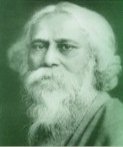
|
|
June |
Ganga Dusshera (Uttar Pradesh), Hemis Festival (Ladakh) |
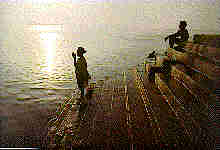
|
|
July |
Rathyatra (Orissa), Guru Purnima (Across the country) |

|
|
August |
Independence Day (15.),Janamashtami (Across the country), Onam (Kerala), Nag Panchami (West-Bengal, Maharashtra, South India), Rakshabandhan (North india), Ganesh Chaturthi (Maharashtra, Tamil Nadu, Andhra Pradesh, Karnataka), Teej (Rajasthan) |

|
|
September |
Tarnetar Mela (Gujarat) |

|
|
October |
Birthday of Mahatma Gandhi (02.), Durga-Puja (Bengal), Navratri (Across the country), Dusshera Mela (Across the country), Marwar Festival (Jodhpur) |

|
|
November |
Birthday of Guru Nanak (30.), Sharad Purnima (Across the country), Diwali (Across the country), Ka Pomblang Nongrem (Meghalaya), Sonepur Fest (Bihar), Pushkar Fest (Pushkar), Hampi Festival (Hampi), Chemre Festival (Ladakh), Thikse Festival (Ladakh) |
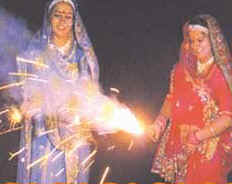
|
|
December |
Christmas (25.), Konark Dance Festival (Orissa) |

|
Cuisine
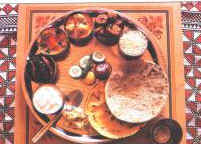 |
Thanks
to hundreds of Indian restaurants, which have mushroomed in the
capitals of the world, Indian cuisine is no longer a mystery. The
myth that surrounded Indian that it was all curry and nothing else
is gradually vanishing. So great is the variety of food in India that a visitor who has grown on the notion that it is the land of curry and rice is in for a surprise. Curry, to the Indian, is not the name of a dish. It encompasses a whole class of dishes. There are any numbers of curries, made with meat, fish, chicken, and vegetables and on occasions, fruits. |
| The
only common factor is that they all contain freshly ground
spices, including turmeric, and have 'gravy'. The
combination of spices, often passed from mother to daughter
or from one chef to his son, makes one curry totally
different from other curries. There is no standard curry
powder mixture. Every housewife has her special mix of
spices. And the proportions vary from recipe to recipe. It may be interesting to note that most of these spices have a medicinal value, which westerners, often with their antibiotic obsessions, tend to disregard. But an Indian cook knows which spice will have what effect on the digestive system and uses it accordingly. |
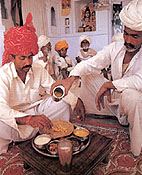 |
 |
The most commonly used spice and herbs in Indian cooking are
asafetida, cardamom, clove, cinnamon, coriander, garlic, ginger,
turmeric and aniseed. Let us examine their uses. Turmeric is used almost in every dish. It helps to preserve food and gives the dish a pleasant yellow natural colour. It has also digestive properties. Ginger is considered good for digestion and many people like it not only in their food but also eat it as a salad. Coriander seeds or beans are used in most Indian dishes. They are supposed to have a cooling effect on the body of a person who eats the food. Cardamoms are strong and sweet. They have a nice flavour. They are used in all dishes and in some curries too. They help in digestion. Saffron, the most expensive spice, can create a lot of effect and fragrance with a little quantity. To produce one pound of saffron, several thousand flowers are needed. It is grown in the valley of Kashmir and is used for its flavour. Mustard, cinnamon, nutmeg, pepper, cloves, poppy and caraway seeds are also used in Indian dishes. |
Masala is the name for the name for a blend of many spices. It may be dry or in liquid paste. The chef decides what will go in the spice blend. Garam Masala is a blend of fragrant spices only. It can be prepared in advance and stored. Now, various blends of packed Garam Masala are available in stores. The packet tells you for what kind of dish it could be used. The Garam masalas are generally cinnamon, cloves, cumin seeds, mace, coriander seeds, nutmeg, and black pepper.
| here
is a whole range of curry dishes from different parts of
India, each having its own distinct flavour. For the purpose
of convenience, we can broadly divide Indian food into four
different regions-corresponding to Delhi for the North,
Bombay for the West, and Madras for the South and Calcutta
for the East. As will be seen, food habits have been formed
over the years depending on the type of row materials
available in a region. In North India, there is abundance of
meat, vegetables, almonds, dairy products, chillies and
wheat. Therefore, we find people have a preference for wheat
bread in the shape of Nan, Roti, Puri or Parathas. Contrary
to the belief that North Indian is meat-eaters, a meat dish
is only an additional dish while a vegetable curry and dal
(lentil curry) are generally a must in a total meal served
in an Indian home. Cooking media in the north is pure ghee (clarified butter) though it is now used sparingly due to its high price and its fattening potentiality. Other vegetable fats are now more commonly used as cooking media. |
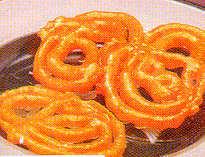 |
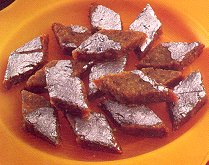 |
In the west and east rice is the staple diet. Fish is plentiful.
So most dishes revolve round these raw materials. The south is
predominantly has been developed over the centuries. There is so
much of variety that a visitor is dazzled by the choice offered to
him. If the preparation of food is important to Indians, its presentation is no less significant. Traditionally, Indian food is served either on a well-washed large banana leaf or in a thali (a large plate made of brass, steel or silver). On it several katoris (small bowls) are placed to hold small helpings of each dish. A typical meal may consist of a meat or fish dish, two vegetable dishes, Dal yoghunt and a sweet dish of Kheer or Halwa. Other accompaniments would be Pickles, Chutneys, Papads, etc. a small piece of lime may be placed in the thali to be used by the guest, if he so wishes.
|
Alcoholic Drinks Alcoholic Drinks |
Although
many Indians shun alcohol, specially the women, the upper crust
of society do enjoy alcoholic drink, which are a luxury for most
Indians.
Imported liquors like Scotch whisky are very much prized. But
Indian-made whiskies, rums, and brandy are not far behind their
western counterparts. These are also popular with foreign residents.
There
are some 30 varieties of Indian beer available. Popular brands
are kingfisher, Hayward and rosy pelican. Indian beer is good.
Alcoholic
drinks and better must be bought from licensed shops. India does
not produce high quality wines. Try them for their taste. Who
knows you may like them?
Drinking
in public is prohibited and is not desirable. You are welcome
to drink in your hotel room or in the hotel bar if you want company.
Some Indian states enforce prohibition-especially Gujarat and
Tamil Nadu. But foreigners in hotels can get permit for drinking.
>Electricity
India has the 220v, 50-cycle system of electricity. Most hotels can provide step-down transformers to enable you use your electrical appliances.
Telecommunication |
Besides
hotels, international telephone facilities exist in major post
officers and markets. There are telephone booths for local and
international calls in busy market areas all over the country.
Telephoning from these places works out much cheaper that from
your hotel room.
India has a direct dialing system linking over 190 countries of
the world, including china. Within India, subscribers trunk
dialing (std) is available for 1000 cities!
During your travel you will see big signs ISD/STD. You can call
anywhere in the world from these booths.
Women Travel
Foreign women tourists in their traditional and graceful attire are not an object of curiosity in India. They mix well with Indian women, especially the educated ones. But foreign women wearing revealing clothes may attract attention and perhaps cat call too from Indian Romeos! Just walk past, ignoring them. Any little indication of friendliness on the part of women can be misunderstood. Women traveling alone in Indian cities during the day and early evening are perfectly safe. But it can be risky for women traveling alone in late at nights, as in any other metropolitan city of the world. Crime against foreign women is virtually unknown in India.
|
Few
golden rules for women traveling alone:
(a) Avoid men too eager to help. (b) Avoid accepting lifts, which you have not asked for. (c) Avoid asking a man for a lift. No harm when a female accompanies him. (d) Avoid free and frank talk with strangers, especially on sex related matters. |








